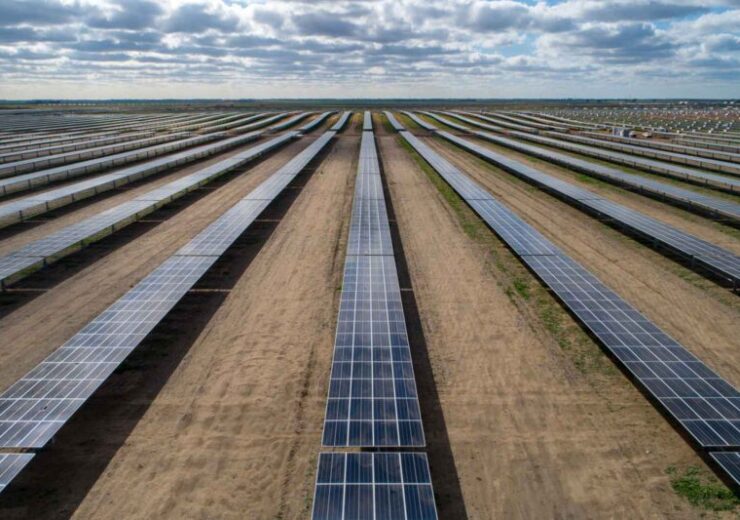RWE Renewables Europe & Australia has been successful in the New South Wales competitive tender process offering “long-term energy service agreements” to long duration storage project developers, with RWE’s Limondale 50 MW/400 MWh project awarded. The storage facility will be located next to RWE’s existing 249 MWac Limondale solar farm, taking advantage of existing grid infrastructure.

The Limondale Solar Farm in Australia. (Credit: RWE Renewables Australia Pty Ltd)
New South Wales has established an ambitious roadmap for replacing ageing coal-fired power stations with zero emissions generation and storage, RWE notes, with the bipartisan policy backed by a schedule of auctions for new renewable and storage capacity out to 2030.
“This success creates further momentum working towards a sustainable future in our core market Australia”, said Katja Wu¨nschel, CEO RWE Renewables Europe & Australia, noting that “In a renewables world, battery storage is key for a reliable, secure and sustainable electricity supply.”
RWE’s energy blog, en:former, noted recently that Australia’s energy transition is picking up steam, with renewables’ share of power generation in Australia reaching 35.9% last year, more than double the level of 2017.
In particular, RWE notes, the country has embraced rooftop solar, with around one in three Australian households now having home solar systems, according to the Clean Energy Council. Rooftop solar contributed 25.8% of renewable energy generation last year, the first time it has accounted for more than a quarter of the country’s green power production, the RWE blog observes.
However, to transform truly a power system still heavily dependent on fossil fuels, particularly coal, more utility-scale solar and wind are required, says RWE. Deployment rates for utility-scale projects were down in 2022 year on year, but the recently published Clean Energy Australia Report charts clear evidence of growing momentum across the renewable energy sector:
- There were 72 large-scale renewable energy projects under construction or with firm financial commitments at end-2022, up from 66 at end-2021. These comprised 48 solar projects, 21 wind and three bioenergy. Utility-scale solar saw its largest-ever monthly generation in December, at 1505 GWh.
- The deployment of batteries increased last year to 1380 MW/2004 MWh, compared with 921 MW/1169 MWh in 2021.
- Over 5 GW of wind and solar projects started construction last year, the highest level on record.
RWE is currently developing a portfolio of on and offshore wind, solar and battery storage projects across Australia, with “political sentiment swinging behind green growth.”
Increased activity in the renewable energy sector reflects a sea change in the national mood over the past year, says the RWE blog, observing that the federal election of 2022 was dubbed the ‘greenslide’, bringing Labor back into power with a majority for the first time since 2007.
Although Labor’s majority is slim, the Green Party won 4 seats, up from 1, and a group of cross bench MPs, known as the ‘teal independents’, who ran on strong climate agendas, have 11 seats. Action has followed, notes RWE. In December, the government and the state of New South Wales announced a joint deal worth A$7.8 billion (US$5.2 billion) to support eight critical transmission grid and renewable energy zone projects. In total, the government plans a grid modernisation investment of A$20 billion under its Rewiring the Nation policy.
This huge new investment in grid infrastructure is designed to facilitate the accelerated build out of renewable energy projects in order to reach the government’s target of 82% renewable energy on the grid by 2030. The new government also legally adopted in September a target of reducing the country’s greenhouse gas emissions by 43%, relative to 2005, by the end of the decade.
This ups the country’s climate ambitions substantially from the 26-28% target advocated by the previous administration, comments RWE, and the renewable energy project pipeline has increased as a result. According to the Clean Energy Council, as of April, 16.4 GW of new renewable energy capacity had reached financial closure, representing A$23.5 billion in investment. In fact, the pipeline of all projects under consideration is much bigger – more than enough to supply Australia’s electricity needs, according to some estimates.
These include a growing number of offshore wind projects and giant solar farms. Currently more than 50 GW of offshore wind projects have been announced around the country.
Australia has gradually been putting in place the legislative framework for offshore wind, which would provide a huge boost to the construction of battery capacity, says en:former. The offshore Electricity Infrastructure Act was passed at the end of 2021. Then, in June last year, the licensing regime for the sector’s regulation came into being.
In December 2022, the government declared the Bass Strait off Gippsland (Victoria) as the country’s first offshore wind zone, an area which could host more than 10 GW of offshore wind, and July 2023 saw Hunter (off the NSW coast) declared as the second offshore wind zone, with a potential installed capacity of some 5 GW.
Nevertheless, Australia remains a large fossil fuel user and exporter, notably of coal and liquified natural gas, notes the RWE blog. It faces the twin challenge of domestic decarbonisation and transforming an export-orientated economy based on traditional fuels, but is already achieving success. In 2022, production of lithium, vanadium and cobalt – all key battery minerals – rose by 9%, 10% and 6% respectively, according to the Australia Identified Mineral Resources report. However, as en:former suggests, an even bigger opportunity may lie in clean electricity and green hydrogen exports to the energy-hungry economies of Asia, many of which also remain heavily dependent on coal.
Some of the largest renewable energy projects worldwide have been floated in Australia with the aim of securing a share of future trade in clean energy commodities.
This article first appeared in Modern Power Systems magazine.
